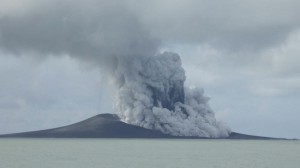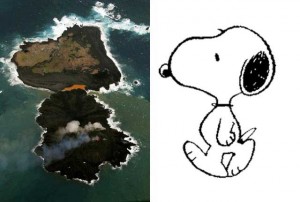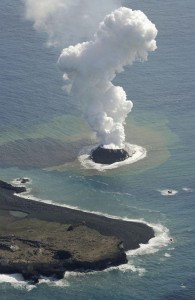Inspired by a new map plotting the world’s most recently natural formed pieces of land Private Island News takes a closer look at six volcanic eruption islands which are here to stay.
During the past couple of years, volcanic eruption islands have become almost commonplace within the pages of Private Island News with five brand new islands forming in the past couple 36 months alone. Indeed, whilst it is said that underwater eruptions occur as often as 20+ times per year, very few of the eruptions penetrate the ocean surface to form a brand new island. And, as touched upon in our last article, even fewer still go on to form a long-lasting island.
Despite a spectacular birth surrounded by sparks, smoke and flames, the majority of the world’s volcanic eruption islands enjoy a short lifespan of around five to six months. As they often tend to be formed on a porous base of ash and pumice, many of islands are so fragile that they simply cannot survive life on the ocean waves, quickly eroding away into the murky depths from whence they came.
From time to time, however, volcanic explosions have been known give birth to a more durable type of eruption islands – islands formed with solid-lava base, capable of riding out the fiercest of sea storms and redrawing the planet’s geopolitical boundaries. Inspired by a new map plotting the world’s most recently natural formed pieces of land Private Island News takes a closer look at six volcanic eruption islands which are here to stay.
Capelinhos, Azores
Towards the end of September 1957, the sea bed exploded just of the coast of the Ilha do Faial in Portugal’s Azores Archipelago. The incredible eruption lasted thirteen months, sending huge streams of lava flying above the surface of the Atlantic Ocean. The explosion spawned 300 seismic events, hurled ash 1 kilometer and formed an island which, after 12 months, had grown so large that it merged with nearby Ilha do Faial. The residents of Faial were less than impressed by their new, 2 kilometer long peninsula – 300 houses were destroyed in the explosion and over two thousand residents were forced to evacuate to the US and Canada.
Surtsey, Iceland
On November 14th 1963 the crew of a fishing boat discovered an erupting volcano 35 km off the coast of Iceland. The dramatic display of sparks, ash and lava eventually gave way to the tiny island of Surtsey – an island which has continued to surprise scientist since it was formed.
Whereas plants tend to be the first life forms to populate new land, on Surtsey, the first creatures to make themselves feel at home were carnivores. Carnivorous spiders, to be precise, which are thought to have floated across to the island on pieces of passing driftwood and flotsam. They were followed by their food supply – tiny insects which floated across from the mainland in the wind.
The first fauna to appear on the island came some time later – a series of simple mosses, whose seeds were washed up by the waves. Further plants took root as a result of the islands burgeoning avian population, whose guano made the island a very fertile place indeed. Earthworms and mollusks soon followed, transforming the island into a thoroughly thriving eco-system.
One animal is yet to establish itself on the island – and with good reason. Humans aren’t allowed to disturb the unkempt island paradise – Surtsey has been transformed into a natural haven in order to preserve its unusually unspoiled condition.
Nishinoshima, Japan
In 1973, a volcano approximately 1000 km to the south of Tokyo spat out a smoldering island known as Nishinoshima. Unlike the fertile haven of Surtsey, this jet-black Japanese island is relatively free of greenery. Yet what the island lacks in flora, it more than makes up for on the fauna front – according to a local research team, ants, butterflies, beetles and flies can all be found in abundance on the island.
Nijima
Japan’s chief cabinet secretary, Yoshihide Suga, had good cause to smile when he joked about Japan’s territory expanding at a rapid rate.Formed some 40 years later in 2013, Nijima started life as the aforementioned island’s little sister – located half a kilometer away from Nishinoshima. These days, however, they’re more like conjoined twins. Nijima continued to grow and grow and grow until it finally “big sis”.
Zubair Islands
The earth certainly shook for residents of Yemen back in 2011. Yet aside from a huge tremor felt along the counties coastal region, there didn’t appear to be anything out of the ordinary. A group of fishermen soon found the final piece of the puzzle – a smoldering column of ash had torn through the ocean to create a brand new island in the Red Sea.
The region enjoys volcanic eruption island friendly conditions – lots of seismic activities and a series of shallows that are just 100 m below sea level. So ideal are the conditions here, that in 2013, the so-called Zubair Archipelago gained yet another new member in 2013 – making that two islands in just two years.
Unnamed
All the signs were there – the blue hues of the South Pacific gave way to green and then brown as the seismic activity in the region effected the ocean’s acidity and spewed out a heavy cloud of ash and stone. By late 2014, the submerged volcano Hunga Tonga-Hunga Ha’apai was spitting out such huge quantities of fire and ash that the eruption finally broke through the sea surface, bringing with it a new island. Whether it’s here to stay remains to be seen – whilst it only appeared in January however, the signs look good. The world’s newest piece of land still languishes without a name, however – that decision belongs to the King of Tonga, who has the naming rights of all lands that exist (and appear) within his sovereignty.
Related Articles:
- A New Island is Born After a Spectacular Explosion in Tonga (January 2015)
http://www.privateislandnews.com/20150129-pacific-ocean-a-new-island-is-born-after-spectacular-volcanic-eruption-in-tonga/
- Russian Military Helicopters Discover New Island in Arctic Waters (December 2014)
http://www.privateislandnews.com/arctic-russian-military-helicopters-discover-new-island-in-arctic-waters/
- An Island is Born – New Volcanic Island Continues to Grow and Grow (April 2014)
http://www.privateislandnews.com/japan-an-island-is-born-new-volcanic-island-continues-to-grow-and-grow/ - This Brand New Island Has a Very Famous Face (January 2014)
http://www.privateislandnews.com/japan-this-brand-new-island-has-a-very-famous-face/





